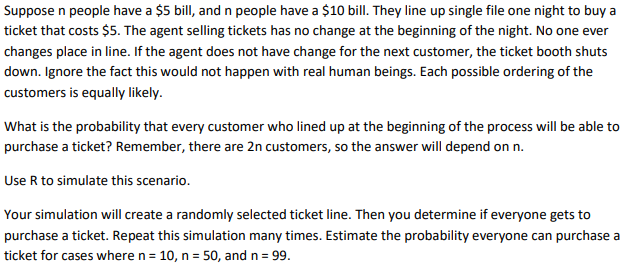Suppose n people have a $5 bill, and n people have a $10 bill. They line up single file one night to buy a ticket that costs $5. The agent selling tickets has no change at the beginning of the night. No one ever changes place in line. If the agent does not have change for the next customer, the ticket booth shuts down. Ignore the fact this would not happen with real human beings. Each possible ordering of the customers is equally likely. What is the probability that every customer who lined up at the beginning of the process will be able to purchase a ticket? Remember, there are 2n customers, so the answer will depend on n. Use R to simulate this scenario. Your simulation will create a randomly selected ticket line. Then you determine if everyone gets to purchase a ticket. Repeat this simulation many times. Estimate the probability everyone can purchase a ticket for cases where n= 10, n = 50, and n = 99.
Suppose n people have a $5 bill, and n people have a $10 bill. They line up single file one night to buy a ticket that costs $5. The agent selling tickets has no change at the beginning of the night. No one ever changes place in line. If the agent does not have change for the next customer, the ticket booth shuts down. Ignore the fact this would not happen with real human beings. Each possible ordering of the customers is equally likely. What is the probability that every customer who lined up at the beginning of the process will be able to purchase a ticket? Remember, there are 2n customers, so the answer will depend on n. Use R to simulate this scenario. Your simulation will create a randomly selected ticket line. Then you determine if everyone gets to purchase a ticket. Repeat this simulation many times. Estimate the probability everyone can purchase a ticket for cases where n= 10, n = 50, and n = 99.
C++ Programming: From Problem Analysis to Program Design
8th Edition
ISBN:9781337102087
Author:D. S. Malik
Publisher:D. S. Malik
Chapter5: Control Structures Ii (repetition)
Section: Chapter Questions
Problem 7PE
Related questions
Question

Transcribed Image Text:Suppose n people have a $5 bill, and n people have a $10 bill. They line up single file one night to buy a
ticket that costs $5. The agent selling tickets has no change at the beginning of the night. No one ever
changes place in line. If the agent does not have change for the next customer, the ticket booth shuts
down. Ignore the fact this would not happen with real human beings. Each possible ordering of the
customers is equally likely.
What is the probability that every customer who lined up at the beginning of the process will be able to
purchase a ticket? Remember, there are 2n customers, so the answer will depend on n.
Use R to simulate this scenario.
Your simulation will create a randomly selected ticket line. Then you determine if everyone gets to
purchase a ticket. Repeat this simulation many times. Estimate the probability everyone can purchase a
ticket for cases where n = 10, n = 50, and n = 99.
Expert Solution
This question has been solved!
Explore an expertly crafted, step-by-step solution for a thorough understanding of key concepts.
This is a popular solution!
Trending now
This is a popular solution!
Step by step
Solved in 5 steps with 5 images

Knowledge Booster
Learn more about
Need a deep-dive on the concept behind this application? Look no further. Learn more about this topic, computer-science and related others by exploring similar questions and additional content below.Recommended textbooks for you

C++ Programming: From Problem Analysis to Program…
Computer Science
ISBN:
9781337102087
Author:
D. S. Malik
Publisher:
Cengage Learning

C++ Programming: From Problem Analysis to Program…
Computer Science
ISBN:
9781337102087
Author:
D. S. Malik
Publisher:
Cengage Learning